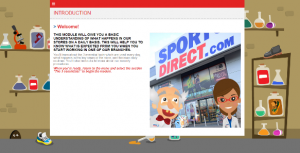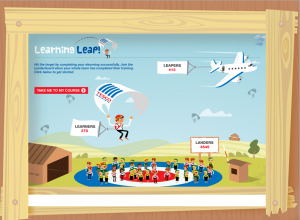What are retailers getting right (and wrong) in workplace…

A new report is giving fresh insight into workplace learning in the retail sector. You may find it challenges your assumptions about training in retail.
We’ve picked out some key facts that shed light on what’s working for retailers and what’s not.
Towards Maturity’s Sector Benchmark Report, Embracing Change in Retail Businesses* looks at the learning practices of 40 retail organisations. More than half are multi-nationals. The study examines their tactics and approaches to Learning and Development (L&D).
The report reveals how retailers are doing compared to the average performance in other sectors. Retailers are also benchmarked against the organisations achieving the best results. They are the Top Deck. No retail business makes it into this upper 10% of consistently high-performers.
Why is that?
We’ll be looking at what’s holding retail back and where the sector is making encouraging strides in performance.
Investment in skills
When was the last time your training budget went up?
Financial pressure is a way of life for most learning professionals. Some of you won’t have seen resources increase for several years. But the Towards Maturity report shows a different story in the retail sector.
Forty-seven percent of retail businesses have increased their budget in the last two years. The same number plan to make a further increase in the next two years. This compares with just 38% across all sectors.
Almost 80% of businesses are using budgets to increase technology-enabled learning. Learning teams are also growing more rapidly in retail than in any other sector.
Retailers are expanding their learning teams twice as fast as the top performing organisations. This is mainly in content development and instructional design. Retailers offer a wide and impressive range of skills training. The sector is on a par with the Top Deck in offering induction and leadership training.
Retailers lead the board in providing customer handling and Health and Safety training. The level of commitment and investment in training by retailers is encouraging. It bodes well for the future of the sector. But the report warns that retailers need to use their resources innovatively to achieve the benefits they seek.
Developing Millennials
Millennials are important to retailers, not just as customers but as employees. A study by PayScale shows that the most common job for Millennials in the USA is retail work. This group (aged between 19 and 30) is five times more likely to be working in retail than any other.
The report reveals that retailers want to focus on Millennials in their learning strategy. Sixty-five percent of retail businesses said 'strengthening training appeal for Millennials' is a key driver of their L&D strategy. This compares to an average of 56% across sectors.
Most retailers recognise the importance of mobile for Millennials. So it's no surprise that 87% want to allow their learners to use their own devices for learning. Only 31% of retailers are achieving this goal but that's still above average. Retail is moving in the right direction in trying to change strategy to meet the needs of a target audience.

Find out how sports clothing retailer, Sports Direct is using mobile in its induction programme.
Bottom line impact
In a competitive sector like retail, delivering value and bottom line impact is fundamental. The Towards Maturity report offers some encouraging data in this area.
“Technology-enabled learning is making a significant contribution to the business bottom line where measures can be attributed to specific learning interventions.”
Retail is performing above average in some Key Performance Indicators (KPIs). The sector stands out compared to others in the following:
- Improvement in ability to change procedures and projects
- Staff satisfaction and engagement
- Time to competence
But there are also some areas of concern. Only 9% of retailers are achieving business cost reductions from learning activities. Just 2% are seeing a drop in staff turnover.
Completion rates
Many organisations are now using technology in compliance. Did you know that retailers are leading the way in moving Health and Safety training online?
The sector exceeds any other, with 71% offering e-enabled Health and Safety skills. Most retailers are also offering industry-specific mandatory training online.
But retailers are reporting lower than average completion rates. The gap is more than 10% compared to other sectors. Employees in retail either see little value in improving their skills or lack the motivation and encouragement to do so, says the report.

Find out how Tesco used a campaign approach to help 4,000 learners complete compliance training in just four weeks.
Learner choice
Retailers are offering a wide choice of training topics but poor flexibility. Learners can get support on a wide range of skills - more so than any other industry. But the options on how, when and where staff can access training are limited.
Retailers need to do more to make learning convenient for workers. They are lagging behind in giving learners clear information about opportunities. Employees in other sectors are twice as likely to have an appraisal discussion about their development. Incredibly, no L&D professionals in retail think their learners have the skills to manage their own learning.
Are retail businesses out of touch with their learners?
Social learning
It’s a mixed picture for retail when it comes to social learning. There’s clearly thought and investment going into supporting social and informal learning. Over 50% are using in-house social media platforms to support learning. Forty percent are using externals sites like YouTube and Twitter. Thirty-two percent of L&D managers in retail said they influence their organisation’s social media policy – that outperforms the Top Deck.
But is there resistance to social learning in some retail organisations? Only 4% of senior managers are encouraging it, according to the report. Just 15% of retailers understand how learners are using social media to share ideas outside of L&D.
In summary, we’ve highlighted six findings in the Toward Maturity report. They all reveal some interesting data on the state of workplace learning in the retail sector:
- Investment in skills
- Developing Millennials
- Bottom line impact
- Completion rates
- Learner choice
- Social learning
There’s plenty more in the study to help shed light on the learning challenges in the retail sector.
* Source: Towards Maturity. (2015). Embracing Change – Improving Performance of Business, Individuals and the L&D Team. https://mindtoolsbusiness.com/research-and-reports/embracing-change#downloadReportForm